I understand that a lot of people feel quite intimidated by the idea of spray painting the exterior of their homes when it comes time to paint them.
This really is a step up from the interior walls in terms of both preparation and planning.
By using these tips, we hope to take some heat off you and allow you to breathe easier while tackling your home’s paint job.
Feel free to get creative by customizing these systems and methods based on what works best for you and your property.
Paint rollers are nice and all, but if you ask anyone who’s ever used a paint sprayer.
They’ll tell you that the paint sprayer method is the way to go for getting your surfaces painted in a matter of minutes.
Each coat is smooth, even, and without any uninvited bubbles. So, today I will explain the method of spray painting exterior walls.
How to Spray paint exterior walls?
- Clean the exterior walls: Start by removing any dirt, dust, or debris from the walls. Use a pressure washer or a garden hose and a scrub brush to clean the walls. Allow the walls to dry completely before proceeding.
- Repair any cracks or holes: Use a putty knife and patching compound to fill in any cracks or holes in the walls. Allow the compound to dry completely before proceeding.
- Protect surrounding areas: Cover any areas that you do not want to be painted, such as windows and doors, with plastic sheeting and masking tape.
- Use primer: Apply a coat of exterior primer to the walls to help the paint adhere better and improve its durability.
- Apply paint: Use a paint sprayer or a roller and paint the walls with exterior paint. Apply the paint in thin, even layers, working from the top to the bottom of the walls.
- Clean up: When you have finished painting, clean the paint sprayer or roller and put away any other tools you used. Dispose of any leftover paint according to local regulations.
Safety tip: Always wear a mask and safety goggles when spray painting.
How to Repair any cracks or holes before painting exterior walls?
- Clean the area around the crack or hole: Use a wire brush or a scraper to remove any loose paint or debris from around the crack or hole.
- Fill the crack or hole: Use a putty knife to apply patching compound or spackling paste to the crack or hole. Spread the compound evenly to fill the area completely. Allow the compound to dry completely according to the manufacturer’s instructions.
- Sand the area: Once the patching compound has dried, use fine-grit sandpaper to smooth out the surface of the repair. This will help the paint to adhere more evenly and give a smooth finish.
- Clean the area: Use a clean, damp cloth to remove any dust or debris from the repaired area.
- Apply a coat of primer: To ensure the paint adheres well to the repair and improves its durability, apply a coat of exterior primer over the repair area.
Note: If the crack or hole is larger than a quarter-inch wide or deep, it may be best to consult with a professional contractor to ensure a proper repair.
Here are the Advantages of Paint Sprayers on Exterior Surfaces
Using a paint sprayer on your exterior walls can be extremely beneficial. Not only is the sprayer a powerful tool, but it will save you tons of time and physical pain!
It would be very time-consuming and painful for you to roll paint over your entire house – imagine all that standing!
By using a paint sprayer to glide over the walls of your house, you’ll get the color you want in a flash.
Here you can check out the pictures I took of the house before painting it with a spray gun so that you guys can get help with this.
Before and after pictures I will upload at the end of this post.
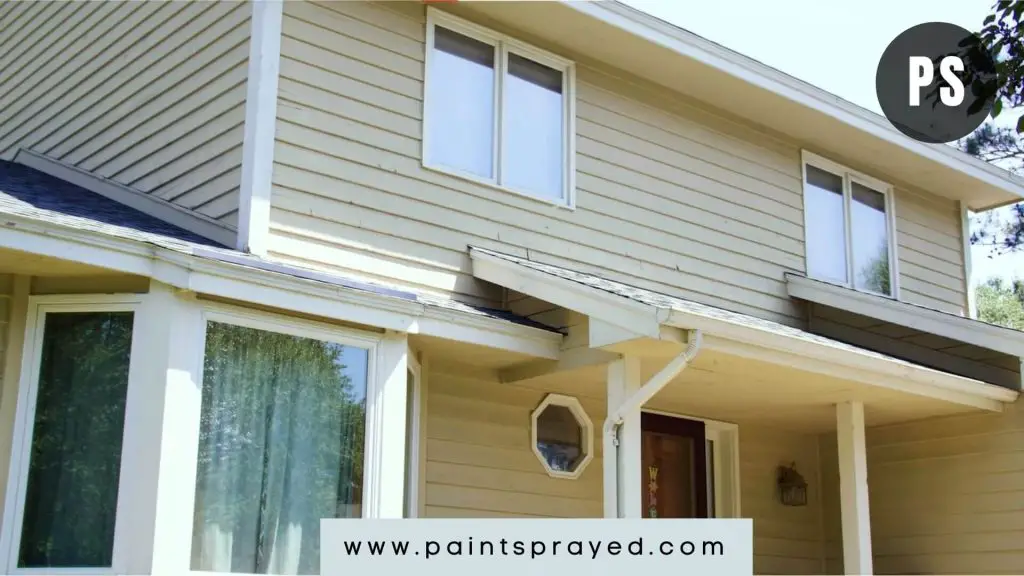
Equipment that you might need during the process
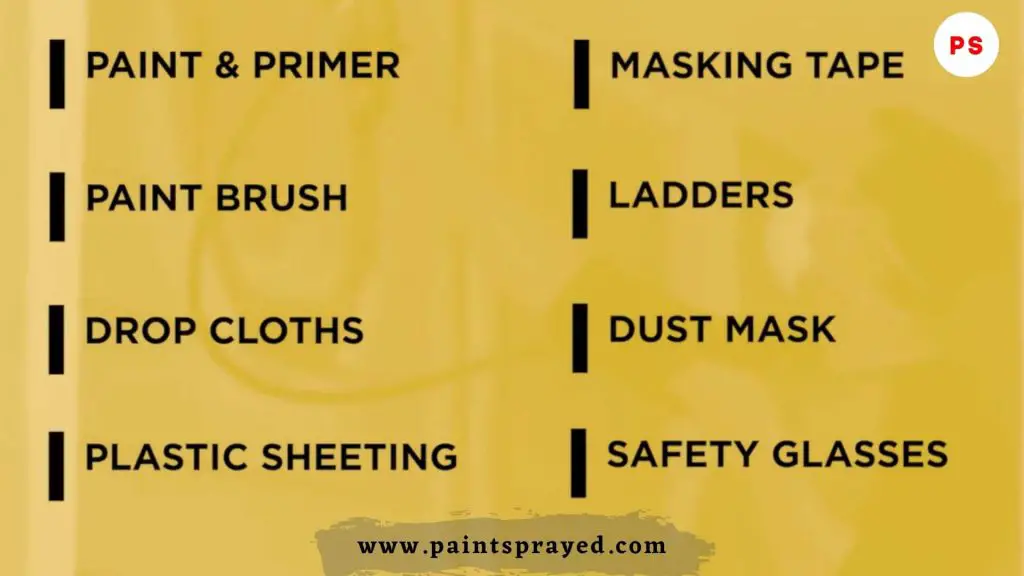
If you’ve decided to paint your home’s exterior, you will definitely want to invest in a paint sprayer to help save yourself time and make the process much easier.
However, there are other items you will need, such as an extra pair of hands or a ladder to access those hard-to-reach sections of your home.
Some other helpful tools include roller extensions, drop cloths, and paper— just to name a few!
- There should be sufficient paint and stains of the color you would like to cover the wall or exterior.
- For the waste, clear and empty the buckets and also the paint storage while refilling your paint sprayer.
- You must have a ladder.
- Masking tape to tape those surfaces of your house which doesn’t need to be painted.
- You should have different tips to cover different areas of your home.
- Stir sticks or any stick to mix your paint properly.
- You also have sheets to protect the ground from paint.
- Spray shield for the protection of arms and face.
- Rags for the purpose of cleanup.
- For additional touches carry some brushes with you.
- Protective gear is a must-have thing, which should include glasses and gloves.
Savvy painters know that those brand-name paint sprayers are nothing without the accessories to go with them.
Fortunately, many of them come with tip extensions included in their purchase price.
This accessory is known for two things: one, you can get into little spaces and corners like behind your stove or under your kitchen cabinets, and two.
It allows you to get more coverage with fewer strokes because you’re not using a brush and roller.

However, if you don’t have access to these tip extensions, there is an easy alternative in order to get the job done quicker by covering more ground in less time.
Use the traditional method of using a paintbrush and roller.
Checking the paint sprayer
Always test your paint gun on a cardboard surface. You must have an extra piece of cardboard with you whether you paint for your own project or for the clients.
Test the gun and make sure of it that there is no finger pattern or blotch.

Now preparation of paint comes in
Before you begin, you need to properly prepare your area.
You will want to move your furniture/objects away from the walls that are going to be painted so that they’re out of the way and don’t get touched by the paint.
And don’t worry about the sidings because we can paint that after drying.
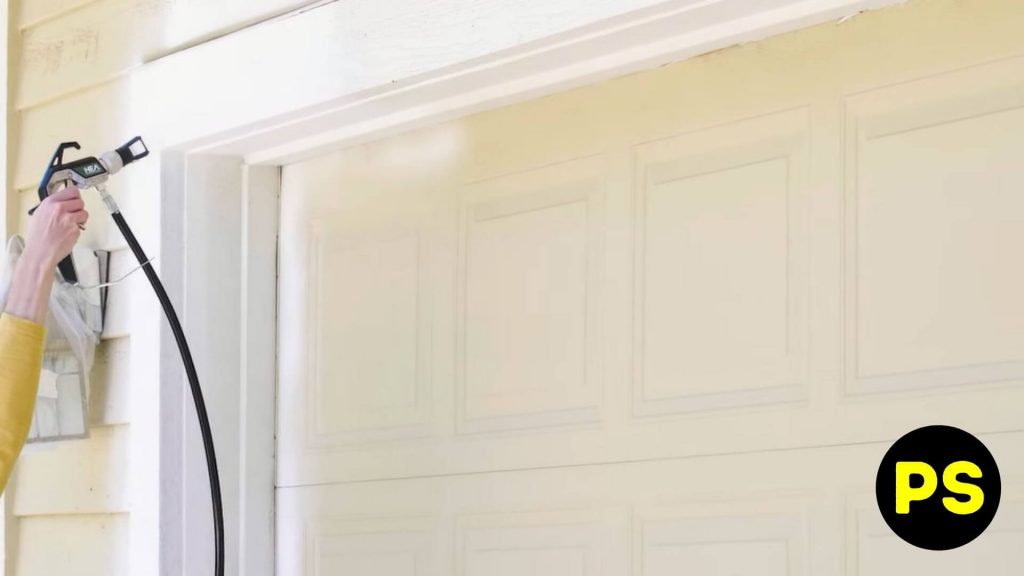
When it comes time to paint, take a good look at the areas you don’t want to be painted. Apply plenty of tape and other coverings over these places so that there is no room for paint overlap!
This process can seem tedious, but when you’re all said and done, you will have a nice exterior with sections of stark contrast.
Between painted and unpainted areas – this will often lead to beautiful design decisions.
Wash the area before spraying
Before you paint your house, it is vital that you pressure wash the entire area and make sure it is free from any old peeling paint or mold.
Any debris that adheres to your walls can easily be transferred onto new paint as you are applying this to them, and may lead to haphazard splatters.
Check for chipped paint and mark those spots. Before starting fix the cracked wood and fix the surface first then start the project.
Just like I have spotted some spots which needed to be fixed on my friend’s house. I fixed those spots first then I continued other stuff.
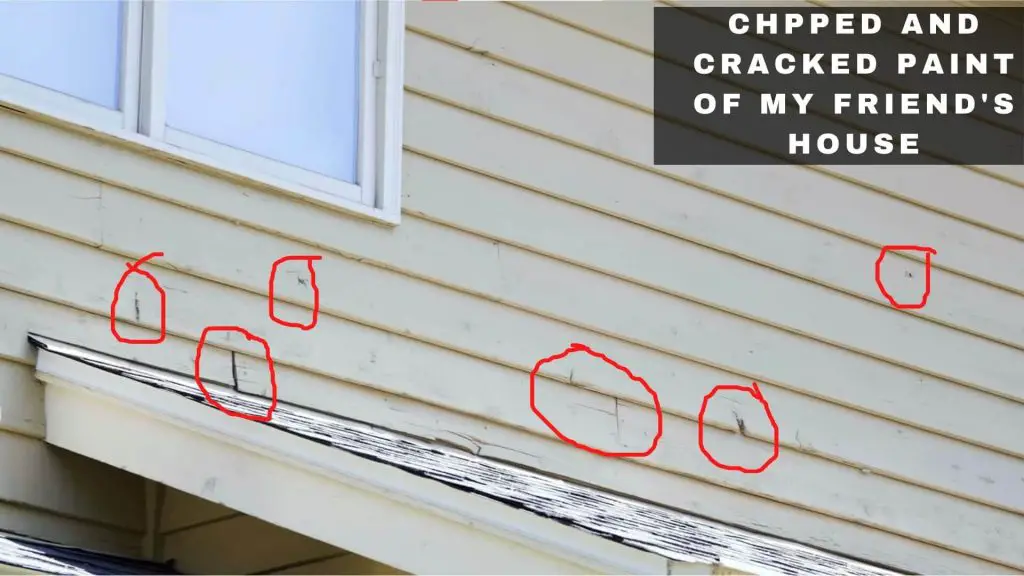
We recommend allowing all of your surfaces sufficient drying time so any moisture does not compromise all of the hard work.
You have put into both preparing for priming and cleaning up after the job has been finished.
The spraying process comes in
I will also show you guys how we painted the house of my friend who just lives nearby. Before the spraying process, we fixed these kinds of spots on the house.
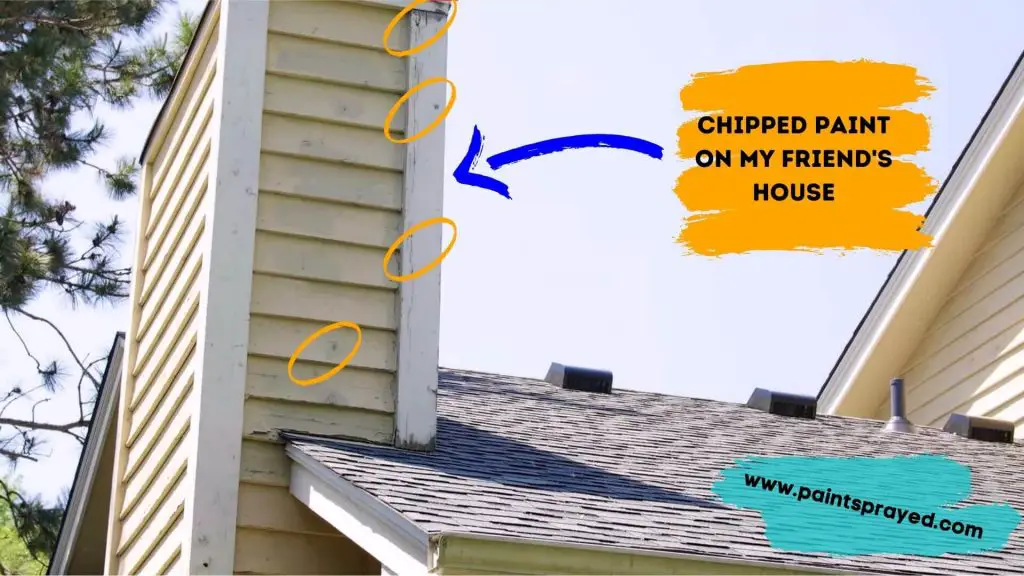
Now you’re ready to paint – but wait! Before you even pick up your sprayer and get started, it’s a good idea to visualize the outcome in your mind.
Think about the color that best fits what you want to achieve, thinks about how thick or thin the lines should be, and most importantly.
Think about how much time you’re willing to put into what could amount to an all-day project.
If rushed, spray paint can be a real pain because of all of the prep work involved with making sure that one’s paint is perfectly level so as not to mess up after applying so much effort to it.
Think carefully about all of this before committing and also double check whether or not any specific surfaces (e.g., plastic surfaces) are paintable according to your end result preferences.
If you have noticeable parallel planks in your walls, the spray should go across them as is.
Usually, you’ll want to follow along the direction of your exposed woodwork or trusses for the smoothest coat. This can also depend on which side is facing up though.
Working in sections which painting
Starting the project from the garage cause it feels easy for me and my friend.
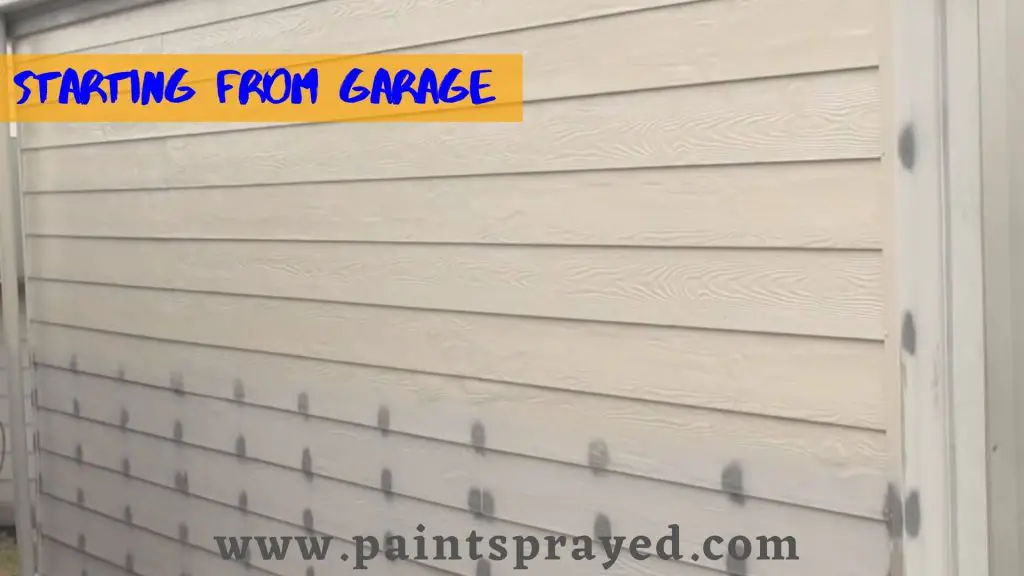
Does it feel like the outside of your property is suffering from a brain freeze? It may be time for a new coat without all of this mess! Give yourself some time to section off specific areas.
Don’t risk getting sunburned or having aching muscles at the end of the day! Section off the parts of your exterior that you can easily reach.
Leave the parts you can’t reach for tip extensions or final touch-ups as soon as everything else is done and dried.
The same mindset applies to artwork and design. You wouldn’t want to try and fit in complicated shapes when your mind is elsewhere so first.
Apply the easy rectangular forms than once you’re happy with those, go back and fill in all the smaller areas.
The idea is not to rush but if you take your time planning how you’re going to apply the paint rather than just blasting it on without a care in the world.
Then you’ll get better results and save yourself from a lot of frustration.
Cleaning after completion
Of course, once the paint has dried, you will want to remove it from your bushes and walls.
Slowly peel back covers from your plants during this process and slowly peel away the tape from the walls too when ready to do so.
Replace any furniture that was moved during this time as well as fixtures that were taken off of the walls.
If these things weren’t removed beforehand all in preparation for painting, make sure you give them a good clean.
Power washing everything once all paint is dry will reduce the amount of cleaning you need to do at a later stage.
After completing the paint by sprayer level the drips with the help of a brush for better finishing.
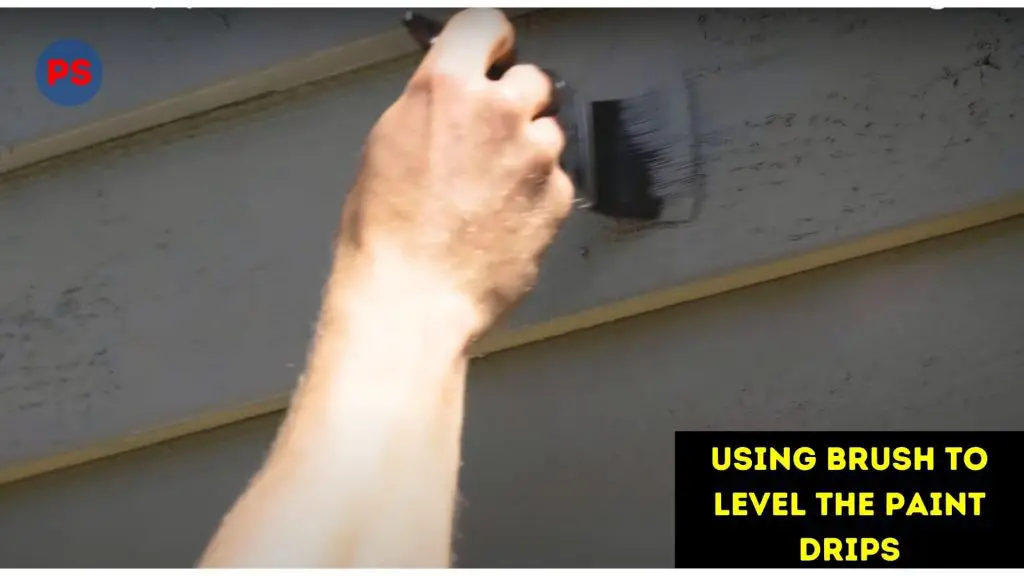
Here are before and after project pictures for amateurs. They can get an idea of how the house looked after repairing its surface and then painting with a paint sprayer.
The front-of-house comparison. The left side is after the results and the right side of the picture is of the previous condition.
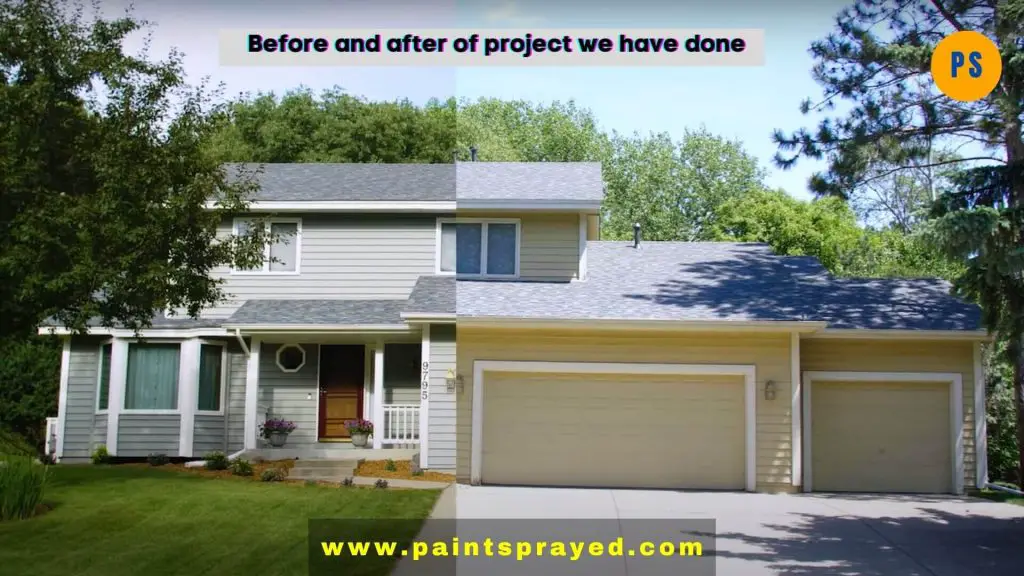
The backside of the house. Before and after results after spraying and fixing it.
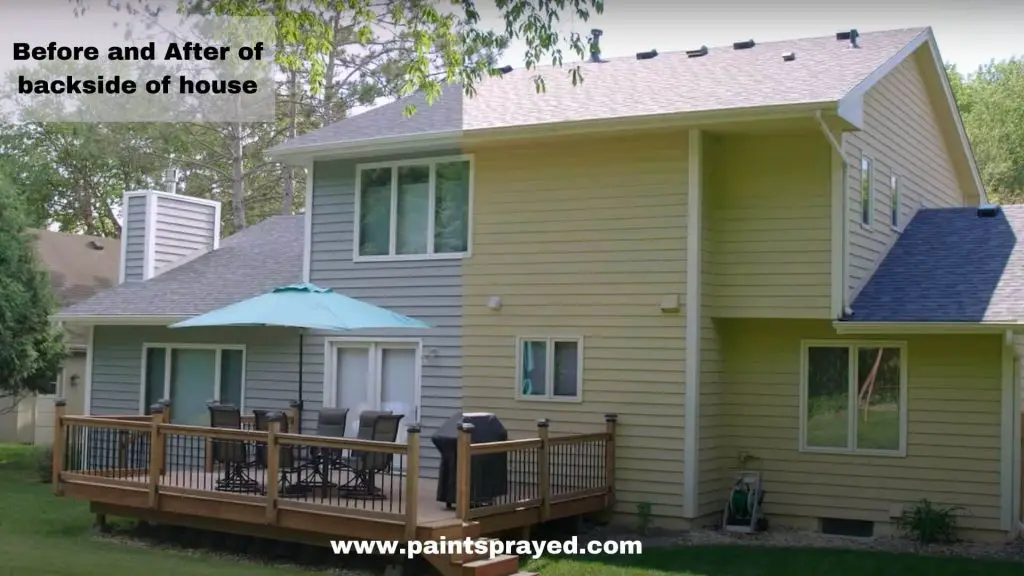
Is it better to spray or roll exterior paint?
Both spraying and rolling exterior paint can be effective, depending on the specific situation.
Spraying can be faster and can cover large areas quickly, but it can also be messier and harder to control the amount of paint being applied.
Rolling can be more precise and can help avoid drips and splatters, but it can also be slower and require more physical effort.
Ultimately, the best method for painting the exterior of a building will depend on factors such as the size of the surface to be painted.
The condition of the surface, and the skill level of the person doing the painting.
Can you spray paint exterior paint?
Yes, it is possible to spray paint exterior paint. Using a paint sprayer can be a quick and efficient way to apply paint to large surfaces, such as the exterior of a house or a fence.
However, there are some important considerations to keep in mind when using a paint sprayer to paint the exterior of a building.
For example, it is important to properly prepare the surface before painting to ensure that the paint adheres well and dries evenly.
It is also important to use the right type of paint for the specific surface and to use the paint sprayer correctly to avoid overspray and drips.
Additionally, it’s important to be aware of the weather conditions, wind direction and temperature, as it can affect how well the paint dries and the final result.
Is it better to spray paint walls or roller?
Both spraying and rolling paint can be effective for painting walls, but they have different advantages and disadvantages.
Spraying can be faster and can cover large areas quickly, but it can also be messier and harder to control the amount of paint being applied.
Additionally, overspray can be a problem and it’s important to protect surfaces that you don’t want to be painted.
If not done properly, spraying can result in drips, runs, and an uneven finish. Spraying is best for large surface areas, such as walls in a commercial setting, or if you want a very smooth finish.
Rolling, on the other hand, is more precise and can help avoid drips and splatters, but it can also be slower and require more physical effort.
It’s also more forgiving in terms of covering mistakes, but the final finish may not be as smooth as when sprayed.
Rolling is best for small to medium surface areas, where precision and control is important, or for textured surfaces.
Ultimately, the best method for painting walls will depend on factors such as the size of the surface to be painted.
The condition of the surface, the type of paint being used, and the skill level of the person doing the painting.
How do you spray the outside of a house?
Spraying the outside of a house can be a quick and efficient way to apply paint, but it’s important to properly prepare the surface and use the right equipment to ensure a smooth and even finish.
Here are the general steps to follow:
- Clean and repair the surface: Remove any loose paint, dirt, or debris from the surface to be painted. Repair any cracks, holes, or other imperfections.
- Power wash: Use a power washer to clean the surface thoroughly. This will ensure that the paint adheres well and dries evenly.
- Caulk: Caulk any gaps or cracks around windows, doors, and trim to prevent drafts and water infiltration.
- Prime: Apply a coat of primer to the surface to help the paint adhere better and improve the final finish.
- Set up the paint sprayer: Assemble the paint sprayer according to the manufacturer’s instructions, and fill it with paint. Test the spray pattern on a scrap piece of cardboard or wood to make sure it’s even and consistent.
- Start painting: Begin spraying the paint in a back-and-forth motion, overlapping each pass slightly to ensure an even coverage. Spray in a well-ventilated area, and protect surfaces that you don’t want to be painted.
- Clean up: Once you’ve finished painting, clean the paint sprayer according to the manufacturer’s instructions to ensure that it’s ready for future use.
It’s important to be aware of the weather conditions, wind direction and temperature, as it can affect how well the paint dries and the final result.
Additionally, it’s always a good idea to wear protective gear like goggles, mask and gloves.
FAQ’s of How to Spray paint exterior walls
Conclusion on How to Spray paint exterior walls
Here it is peeps the method to paint exterior walls and houses. I have explained do’s and don’ts also so that you guys don’t mess up the stuff and get satisfactory results after painting.
The people who are new to this field should ask questions in the comments section so their confusion can be cleared by me or professionals who are working in this field. Happy painting!

Matthew Edward is a professional painter who loves to paint and wants to share useful tips and tricks which he had learned in many years of experience in painting. He also used many products that can be used for painting he has tried and tested each and every product to give an unbias opinion about it in his review. This blog is very useful for those newbies who want to learn painting without making mistakes.






